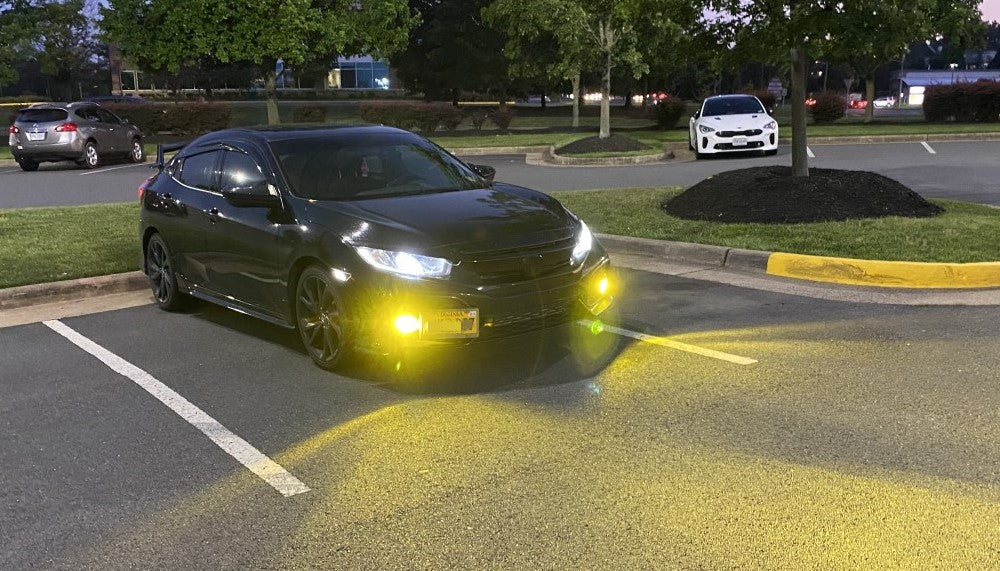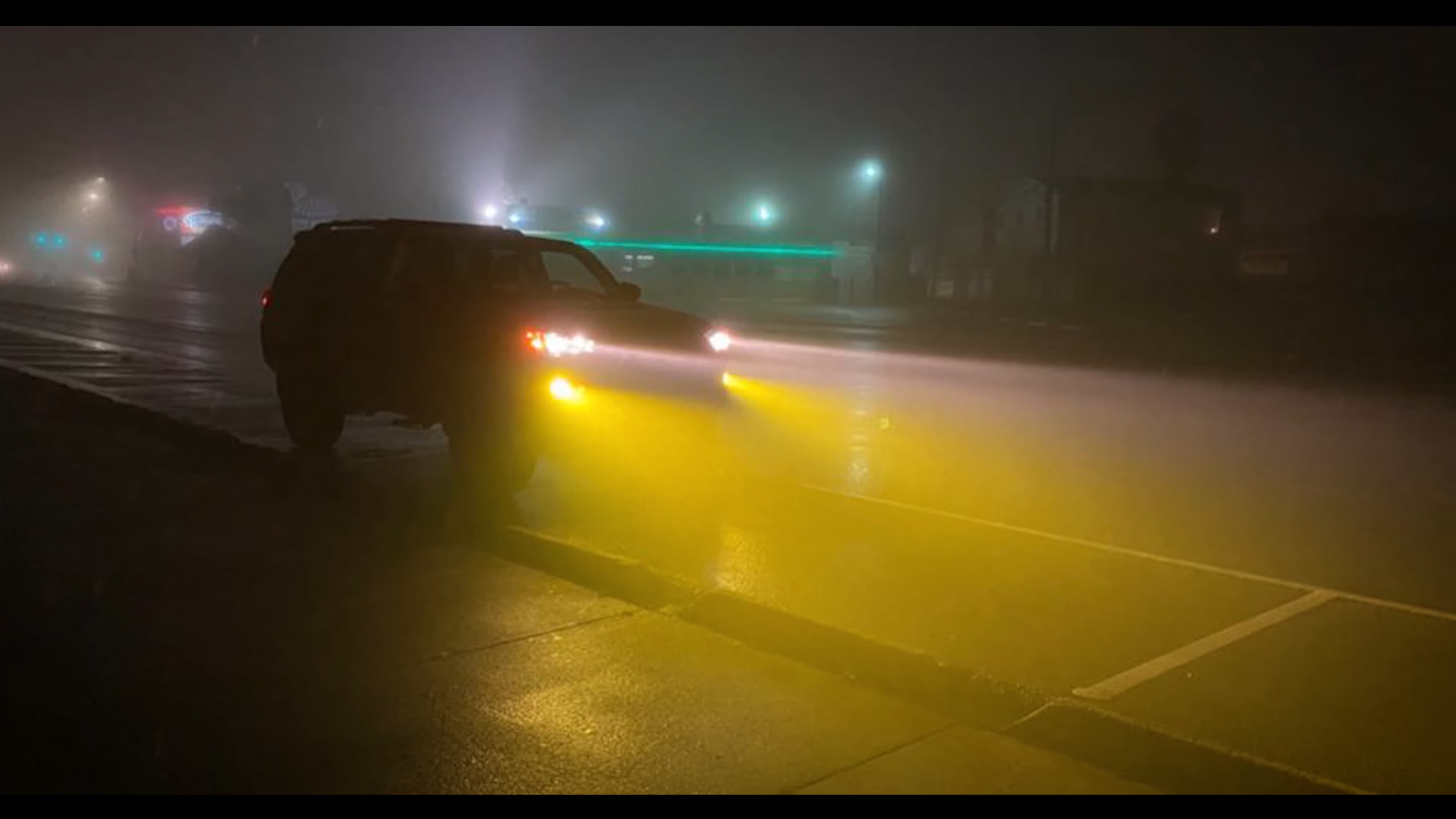Yellow fog lights are better for thick fog and snow due to reduced glare and eye strain. In less severe fog and varied conditions, white lights with higher illumination can be more versatile.
Yellow fog lights are optimal for thick fog and snow due to reduced glare and eye strain. In less severe fog and varied conditions, white lights with higher illumination can be more versatile. When driving in foggy conditions or heavy winters, yellow fog lights are essential for improved visibility and reduced eye strain.
In contrast, white lights are more suitable for less severe fog and varied conditions. The color of fog lights plays a crucial role in enhancing visibility and reducing glare, making it important to choose the right color based on the specific driving conditions. Understanding the benefits of yellow and white fog lights can help drivers make informed decisions to improve safety and visibility while driving in challenging weather conditions.
History Of Fog Light Colors
Yellow fog lights have a long history of being used for improving visibility in adverse weather conditions. The original purpose of yellow fog lights was to reduce glare and eye strain for drivers in dense fog and snow. This color was found to be effective in providing clearer vision in such situations, making it a popular choice for many years.
Over time, the transition to white and amber fog lights took place, offering different benefits for varying driving conditions. White lights, with their higher illumination, were found to be more versatile in less severe fog and varied weather conditions. On the other hand, amber lights were recommended for specific environments such as dust, snow, and fog, offering dimming or high/low capability for improved visibility.
Color And Visibility
Yellow fog lights are often considered better than white fog lights for driving in thick fog and snow due to their reduced glare and eye strain. The longer wavelengths of yellow light penetrate fog and snow more effectively, improving visibility in these conditions. However, white lights offer higher illumination and can be more versatile in less severe fog and varied conditions. When it comes to choosing fog light color, it’s important to consider the specific driving conditions and the level of visibility required.
Scientific Evidence
Scientific evidence suggests that yellow fog lights are better for thick fog and snow conditions, as they reduce glare and eye strain. Yellow lights are optimal for severe weather, while white lights offer higher illumination for less severe fog and varied driving conditions.
Are Yellow Fog Lights Better Scientific Evidence: Studies on Light Color Effectiveness Contrast and Clarity in Diverse Weather Conditions Yellow fog lights have been a topic of debate among drivers, with some claiming that they are more effective in foggy and snowy conditions. Scientific evidence supports this claim, showing that yellow or amber lights are optimal for thick fog and snow due to their reduced glare and eye strain. These lights provide better visibility and help drivers navigate through challenging weather conditions. In less severe fog and varied conditions, white lights with their higher illumination can be more versatile. However, it is important to note that the effectiveness of fog lights depends on the specific weather conditions and the driver’s preferences. It is worth mentioning that yellow fog lights are perfectly legal everywhere in North America. While it is illegal to use fog lights instead of headlights, having yellow fog lights as an additional lighting option is allowed. In conclusion, the choice between yellow and white fog lights depends on the specific weather conditions and personal preferences. Both options have their advantages and can enhance visibility in diverse weather conditions.
Credit: ww2.motorists.org
Driver Experience
When it comes to driver experience, the choice of fog light color can play a significant role. Yellow fog lights are often preferred due to their ability to reduce eye strain and provide better driver comfort. In thick fog and snowy conditions, the reduced glare of yellow or amber lights can be optimal, minimizing the strain on the driver’s eyes. However, in less severe fog and varied conditions, white lights with their higher illumination can offer greater versatility. Real-world preferences and anecdotal evidence show that drivers tend to have varying opinions on the effectiveness of different fog light colors, with some favoring yellow for its ability to improve visibility in certain weather conditions. Ultimately, the choice between yellow and white fog lights depends on individual preferences and driving conditions.
Legal And Safety Considerations
When it comes to choosing the best color for your fog lights, there are legal and safety considerations to keep in mind. Regulatory standards for fog lights may vary depending on your location, but yellow or amber lights are generally considered optimal for thick fog and snow due to their reduced glare and eye strain. White lights, on the other hand, can be more versatile in less severe fog and varied conditions thanks to their higher illumination. It is worth noting that yellow fog lights are perfectly legal everywhere in North America, but it is illegal to use them instead of your headlights. It is also required by law to have two functional headlights. Ultimately, the decision between yellow and white fog lights will depend on your specific driving needs and preferences.

Credit: www.lasfit.com
Environmental Factors
Yellow fog lights are better for thick fog and snow, reducing glare and eye strain. White lights are more versatile for varied conditions. Opt for yellow in heavy winters or daily foggy driving, while clear lights are ideal for high-speed desert driving.
Choose the best option based on your driving environment.
Yellow fog lights, especially amber ones, are ideal for thick fog and snow due to their reduced glare and eye strain. In less severe fog and varied conditions, white lights with higher illumination can be more versatile. Yellow fog lights are legal in North America and recommended for daily foggy or snowy conditions. Clear and intense lights are better for high-speed desert driving, while amber lights are recommended for inclement environments like dust, snow, or fog. Yellow lights are favored for fog conditions as they help focus on the road. Bright white lights offer better visibility in clear conditions, but amber or yellow lights are preferred for foggy situations.Making The Right Choice
Yellow fog lights are a better choice for thick fog and snow as they reduce glare and eye strain. However, for less severe fog and varied conditions, white lights may be more versatile. It’s important to know that yellow fog lights are legal everywhere in North America and are a must-buy for those who drive in foggy conditions or heavy winters.
| Are Yellow Fog Lights Better? When it comes to visibility in thick fog and snow, yellow or amber lights are optimal. For less severe fog and varied conditions, white lights can be more versatile. Yellow fog lights are legal in North America, providing reduced glare and eye strain. If you face heavy winters or foggy conditions, yellow fog lights are a must-have. For high-speed desert driving, clear lights are recommended, while amber lights are advised for inclement environments. Yellow fog lights are favored due to their ability to help drivers focus on the road. |

Credit: blog.theretrofitsource.com
Frequently Asked Questions
What Color Light Is Best For Fog Lights?
For fog lights, yellow or amber lights are the best choice. They have reduced glare and eye strain, making them optimal for thick fog and snow. However, white lights can be more versatile in less severe fog and varied conditions due to their higher illumination.
It is legal to use yellow fog lights, but it is illegal to use them instead of headlights.
Can You Drive With Yellow Fog Lights?
Yes, you can drive with yellow fog lights. They are legal in North America and are preferred for thick fog and snow due to reduced glare and eye strain. However, it is important to note that fog lights should not be used instead of headlights, as it is required by law to have two functional headlights.
Do Yellow Fog Lights Help In Snow?
Yes, yellow fog lights can help in snow by reducing glare and eye strain, improving visibility in severe weather conditions.
Are Amber Or Clear Fog Lights Better?
For thick fog and snow, yellow or amber lights with reduced glare and eye strain are better. In less severe fog and varied conditions, white lights with higher illumination can be more versatile. Yellow lights are the best for fog light colors due to their ability to improve visibility.
Are Yellow Fog Lights Better For Driving In Foggy Conditions?
Yellow fog lights are highly recommended for driving in foggy conditions due to their reduced glare and eye strain. They provide optimal visibility in thick fog and snow.
Can I Drive With Yellow Fog Lights?
Yes, yellow fog lights are perfectly legal everywhere in North America. However, it is important to note that fog lights should not be used instead of headlights. It is required by law to have two functional headlights.
Do Yellow Fog Lights Help In Snow?
Yes, yellow fog lights are beneficial in snowy conditions. If you frequently drive in foggy or snowy areas, yellow fog lights are a must-buy as they enhance visibility and improve safety.
Conclusion
To conclude, the debate on whether yellow fog lights are better than white ones has been ongoing for years. However, based on research and expert opinions, it is safe to say that yellow fog lights are indeed better, especially in dense fog or snowy conditions.
They reduce glare and eye strain, improve visibility, and are legal to use in North America. So if you frequently drive in foggy or snowy conditions, investing in yellow fog lights could be a wise decision.


Leave a Reply